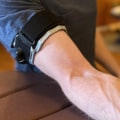Blood flow restriction (BFR) is a training method that partially restricts arterial flow and completely restricts venous flow in the muscles that work during exercise (Scott et al. Performing exercise with reduced blood flow achieved by the restriction of the vasculature proximal to the muscle can be traced back to Dr. Occlusion training involves disrupting blood flow to the limbs at work. A tourniquet or bracelet is placed around the limb and the pressure increases as the workout begins.
Blood flow restriction training is a technique that can be used to perform exercises with a reduced amount of blood flow to the arm or leg. This is often done with a cuff or strap that fits tightly around the limb to reduce, but not completely occlude, blood flow. The benefit of blood flow restriction training is that it allows the person to exercise with less intensity, but still have the benefits of high-intensity training. In several studies and surveys, less than 0.06% of people (healthy adults and older adults with heart disease) had no change in blood clots.
A thrombus large enough to block blood flow, especially if it is found in the smallest vessels, can lead to local tissue ischemia and subsequent tissue death. Hemodynamic response to endurance exercise with and without blood flow restriction in healthy subjects. The cuff should be tightened to a specific pressure that occludes the venous outflow and at the same time allows arterial flow while performing the exercises. Blood flow restriction training, also called occlusion training, involves placing an inflatable cuff on the limb you are exercising.
Gardner notes that people who should not generally use BFR include (but are not limited to) those with current or past blood clots, a diagnosis of a blood clotting disorder, bleeding disorders (including thrombophilia) and infections within the affected limb, as well as pregnant women. The authors recommend the use of BFR combined with different forms of exercise (resisted, aerobic, passive), taking into account the volume and intensity, as well as the amount of cuff pressure, the restriction time, the size and material of the cuff.
The elastic bfr bands
partially restrict the return of venous blood (oxygen-deficient blood that flows from the extremities back to the heart). Blood markers of oxidative stress include protein carbonyls, lipid peroxides and blood glutathione, as well as antioxidant systems.Because the outflow of blood is limited when using the cuff, capillary blood having a low oxygen content accumulates and there is an increase in protons and lactic acid. The key to BFR is that the pressure must be high enough to occlude venous return and allow blood to accumulate, but it must be low enough to maintain arterial inflow. The perceived envelope tension, on a scale of 0-10, has also been used to perform BFR training. Hemodynamic responses are reduced with aerobic exercise compared to resistance blood flow restriction exercise.
The rest periods between sets used during the BFR-RE are generally short and the restriction is usually maintained throughout this period. When you apply firm pressure with the bracelet or band without it being tight enough to cause pain, the idea is that you are only restricting certain blood vessels. .



Leave Reply